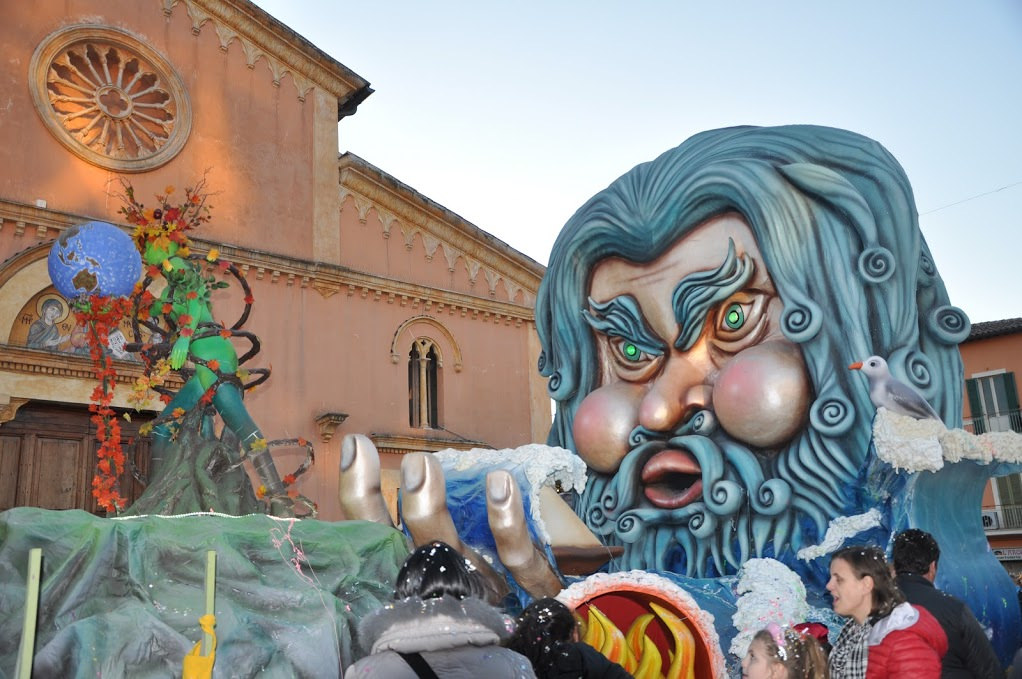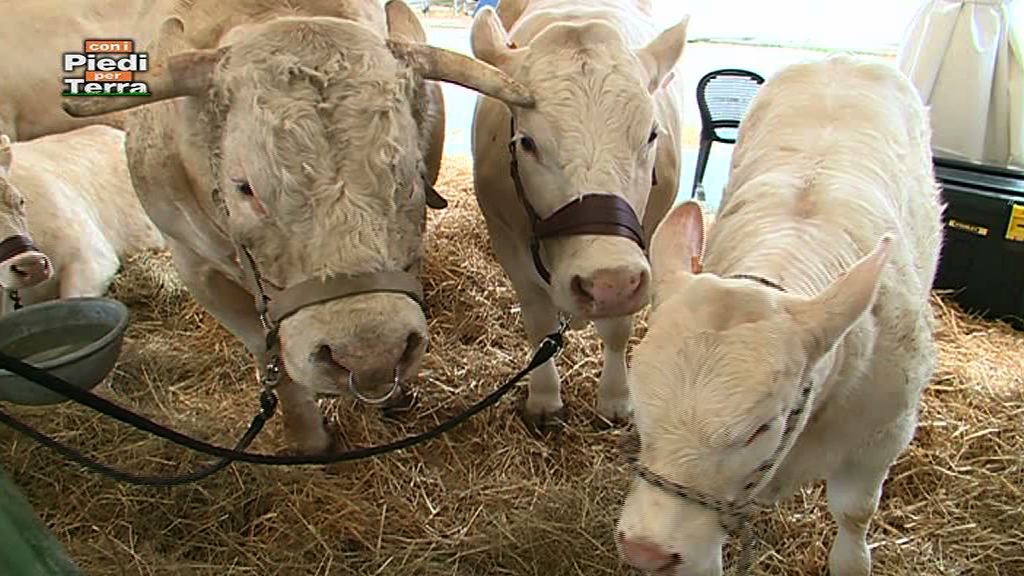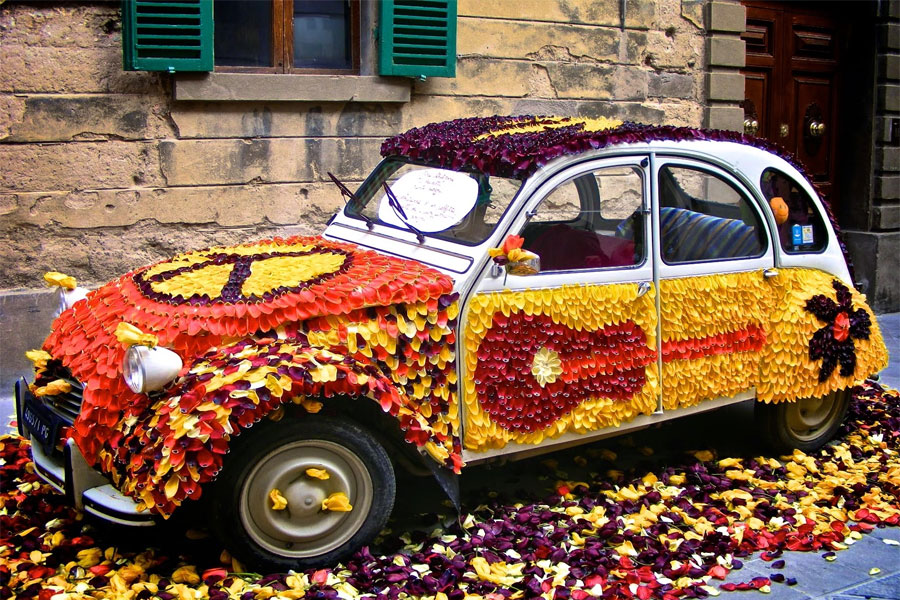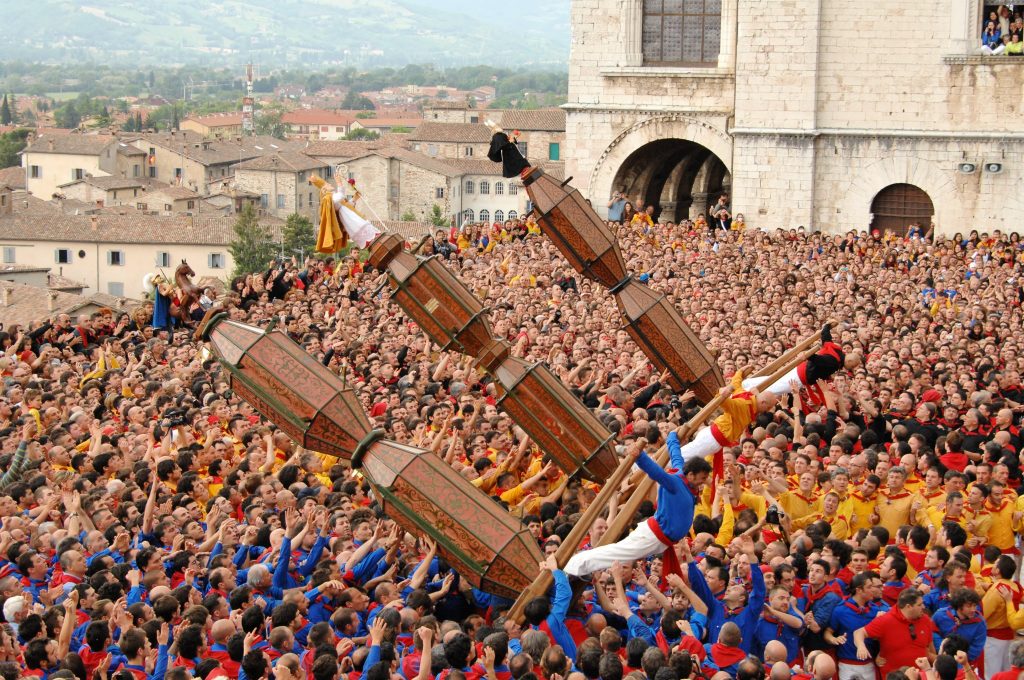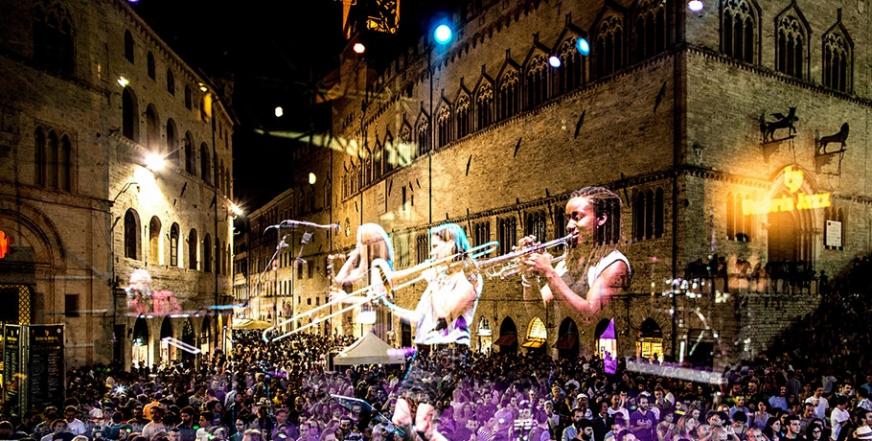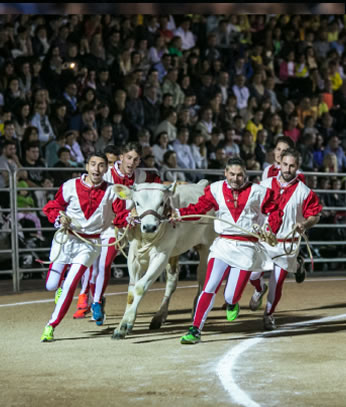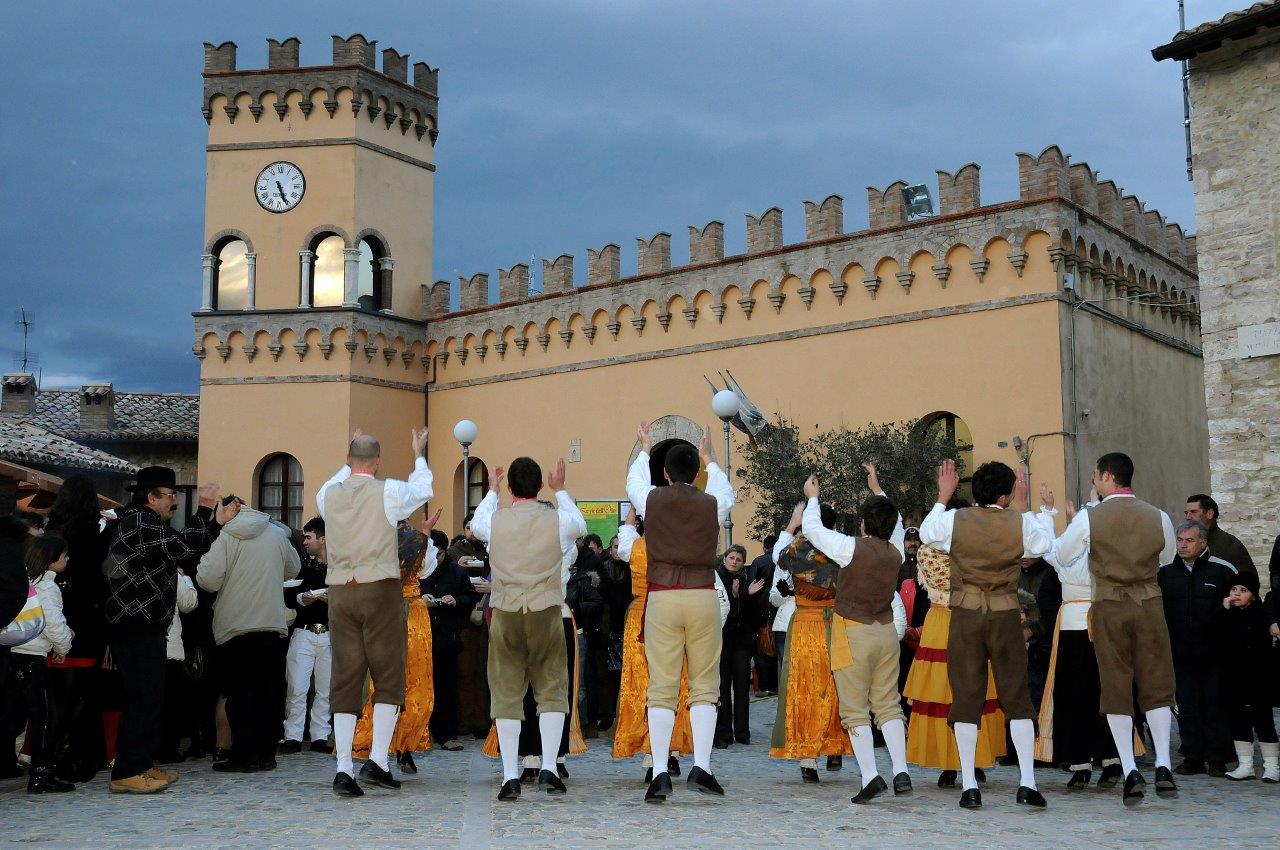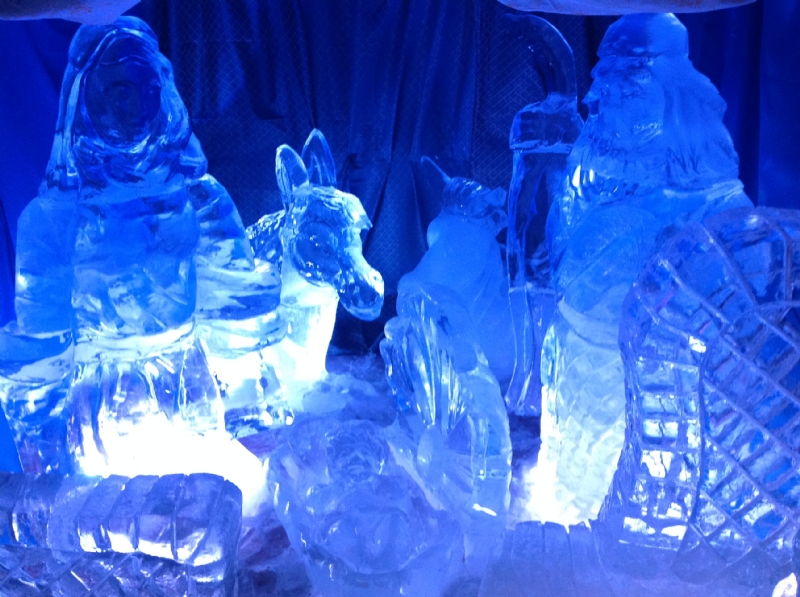English
|
JANUARY |
|||||||||||
|
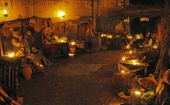
Marcellano: Nativity scene |
||||||||||
|
FEBRUARY |
|||||||||||
|
S. Eraclio di Foligno: Carnival |
||||||||||
|
MARCH |
|||||||||||
|
Bastia Umbra: AgriUmbria |
||||||||||
|
APRIL |
|||||||||||
|
Castiglione del Lago: Tulip Festival |
||||||||||
|
MAY |
|||||||||||
|
Gubbio: Festa dei Ceri |
||||||||||
|
JUNE |
|||||||||||
|
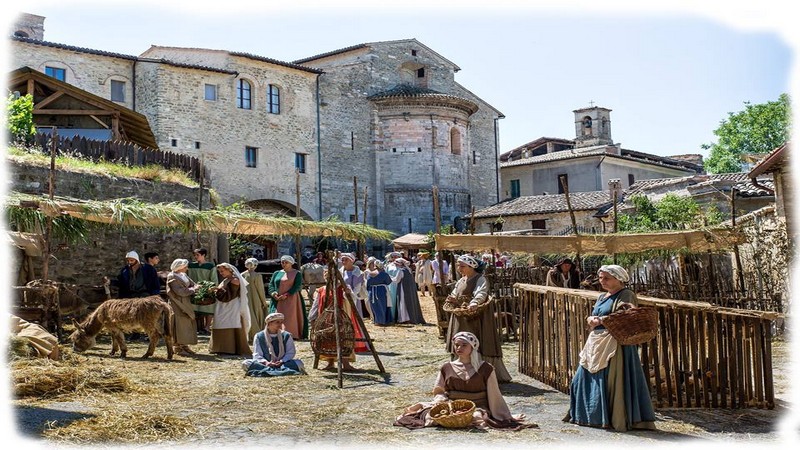
Bevagna: Gaite Market |
||||||||||
|
|
|||||||||||
|
Perugia: Umbria Jazz |
||||||||||
|
AUGUST |
|||||||||||
|
Montefalco: Agosto Montefalchese e Fuga del Bove |
||||||||||
|
SEPTEMBER |
|||||||||||
|
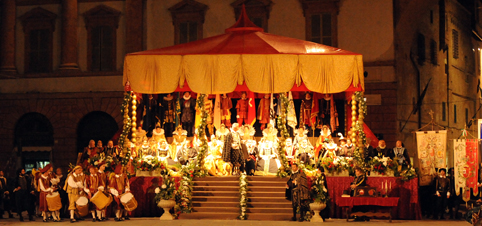
Foligno: Quintana |
||||||||||
|
OCTOBER |
|||||||||||
|
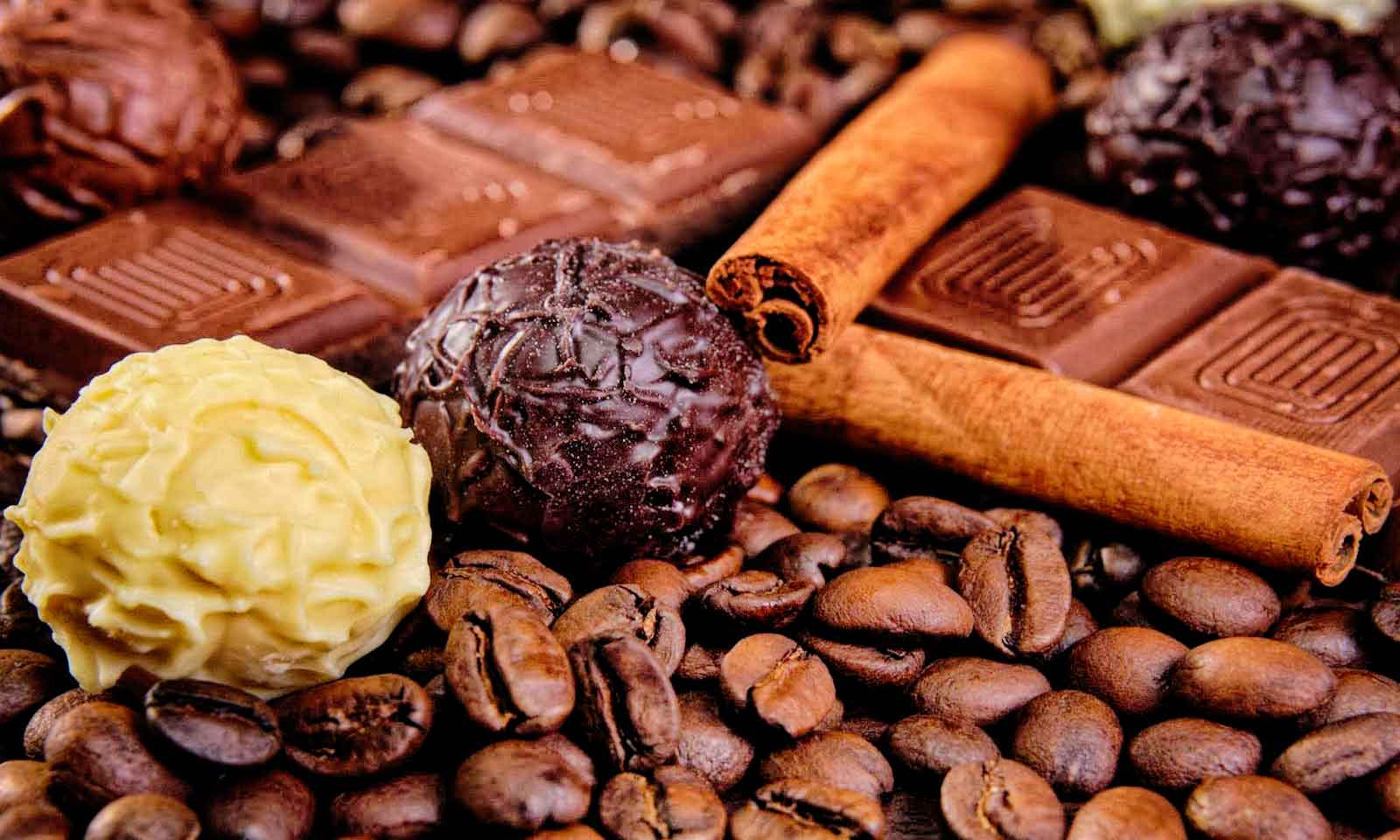
Perugia: Eurochocolate |
||||||||||
|
NOVEMBER |
|||||||||||
|
Giano dell’Umbria: Frasca Festival |
||||||||||
|
DECEMBER |
|||||||||||
|
Massa Martana: Ice Crib |
||||||||||
TODI:
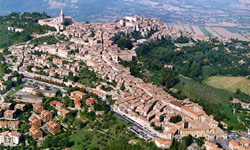 In 2700 BC the Umbrian founded the city of Todi. Its original name was "Tuderte", meaning "border". From the 3rd century BC, the Etruscan and Roman peoples succeeded leaving numerous evidences, such as the Roman "Nicchioni" of Piazza del Mercato Vecchio, in origin, probably part of a Basilica. In 88 BC, Marco Crasso undressed the city of his property, which, after the fall of the Roman Empire, was plundered several times. The figure of the holy Bishop Fortunato goes back to this period and he became the protector of the city. In the Middle Ages, Todi was an enemy of neighboring Orvieto. In the 12th century it became a free municipality, inaugurating a very lucky period, in which the city was enriched with valuable monuments, including the Capitano Palace, the Palace of the Prior, Duomo and the Church of San Fortunato. In 1236 AC Jacopone da Todi was born, the most famous citizen of Todi and one of the first Italian dialect poets. In 1500, after a long period of decadence, the city benefited from the artistic and innovative push of the Renaissance era; the Temple of Consolation is an example. This artistic impulse greatly contributed to Bishop Angelo Cesi, who made numerous works of art.
In 2700 BC the Umbrian founded the city of Todi. Its original name was "Tuderte", meaning "border". From the 3rd century BC, the Etruscan and Roman peoples succeeded leaving numerous evidences, such as the Roman "Nicchioni" of Piazza del Mercato Vecchio, in origin, probably part of a Basilica. In 88 BC, Marco Crasso undressed the city of his property, which, after the fall of the Roman Empire, was plundered several times. The figure of the holy Bishop Fortunato goes back to this period and he became the protector of the city. In the Middle Ages, Todi was an enemy of neighboring Orvieto. In the 12th century it became a free municipality, inaugurating a very lucky period, in which the city was enriched with valuable monuments, including the Capitano Palace, the Palace of the Prior, Duomo and the Church of San Fortunato. In 1236 AC Jacopone da Todi was born, the most famous citizen of Todi and one of the first Italian dialect poets. In 1500, after a long period of decadence, the city benefited from the artistic and innovative push of the Renaissance era; the Temple of Consolation is an example. This artistic impulse greatly contributed to Bishop Angelo Cesi, who made numerous works of art.
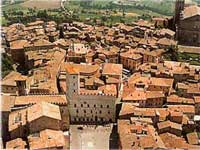 Things to visit in Todi
Things to visit in Todi
- Piazza del Popolo with the Palazzo dei Priori
- Gothic Church of San Fortunato
- November IV square with the ruins of the Rock
- Church of Santa Maria della Consolazione
- Romanesque Church of Sant'Ilario
- Scarnabecco da Bologna sources, Podestà di Todi
- The Roman Opera of the Nicchioni
- Cathedral of the XII-XVI century
- Etruscan-Roman Museum
- The Pinacoteca
MASSA MARTANA:
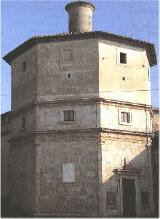 Massa Martana is in the center of Umbria, between the capitals of the provinces of Perugia and Terni; it is enclosed by almost intact walls. The first settlements dating back to the construction of Via Flaminia, around 220 BC. The Roman presence is witnessed by the Ponte Fonnaia, a road construction of the 3rd century BC. Nearby there are the Christian Catacombs, the only one that has been discovered so far in Umbria. The territory is characterized by numerous forests, formed by Mediterranean scrub and the Martani Mountains, whose highest peaks exceed 1000 meters.
Massa Martana is in the center of Umbria, between the capitals of the provinces of Perugia and Terni; it is enclosed by almost intact walls. The first settlements dating back to the construction of Via Flaminia, around 220 BC. The Roman presence is witnessed by the Ponte Fonnaia, a road construction of the 3rd century BC. Nearby there are the Christian Catacombs, the only one that has been discovered so far in Umbria. The territory is characterized by numerous forests, formed by Mediterranean scrub and the Martani Mountains, whose highest peaks exceed 1000 meters.
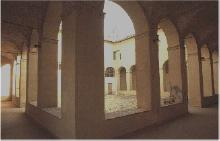 The cool climate and the proximity of the most famous historic-artistic centers, easily accessible by a good road network, give it a privileged role as a summer residence.
The cool climate and the proximity of the most famous historic-artistic centers, easily accessible by a good road network, give it a privileged role as a summer residence.
The city offers to nature lovers many possibilities, for example interesting and healthy hiking in the extensive and intact evergreen Aleppo holm and pine forests, where picturesque castles still preserve many of their original medieval architectures.
 Things to visit in Massa Martana
Things to visit in Massa Martana
- Church of Santa Maria in Pantano, (7th and 8th centuries)
- Abbey of San Faustino, built on the ruins of an ancient Roman villa, recently restored
- Abbey of SS. Fidenzio and Terenzio, dating back to the 11th century
- Abbeys of Santa Maria in Viepri (around 1150 BC)
- Church of Santa Maria della Pace (XVI - XVII sec.)
Every first Sunday of May, the procession at the Sanctuary of Madonna del Fosco (Castagnola, Giano dell'Umbria) is a very popular event. It is a pilgrimage of 20 km, which starts from the parishes of Massa Martana and Viepri and reaches to the sanctuary of the Madonna del Fosco; the procession follows some teams that support the statues of the Saints of the country on the shoulders.
COLLEVALENZA:
 The origins of the village are uncertain. It is thought that the name “Collevalenza” (also said “Colvalenza”) comes from the temple dedicated to Giunone Valentia, who stood in the place of the present castle. Faithful to the Ghibellines of the Chiaravalle family, it was long controversial by the opposing factions. In 1377 AD, the population was heavily oppressed and the castle was largely destroyed by the Guelph Catalano degli Atti. In 1424 AD, the castle was rebuilt and today it is still possible to admire the fifteenth towers and gothic walls with two openings. The center of the city, still furnished with medieval walls, owes its fame to the Shrine of Amore Misericordioso of Madre Speranza. The religious buildings of the sanctuary are one of the most significant expressions of sacred architecture of the second half of the twentieth century; it is an imposing complex with modern receptive structures embedded in a series of buildings located on the slopes of a hill. The central nucleus consists of the Great Church, consecrated in 1965 BC, by the Spanish architect Julio Lafuente, and by the chapel of Amore Misericordioso wanted by Madre Speranza in 1955 AD. Madre Speranza Alhama, in addition to several prodigious phenomena such as the transmutation of water in oil, has been the protagonist in the life of bilocation phenomena. Stigmatized, she often exuded blood. Memorable is the episode that took place in 1960, when, being the land of Collevalenza without water, relying on God (her "engineer"), she pointed to the stick where it was to proceed with the drilling to find the water that would renew Lourdes' wonders. After the breakup of numerous drills (according to mysticism caused by the Demon), the aquifers were found that Madre Speranza called "the relief of the body to find God." Only in 1998 there were almost 800 cases of healing.
The origins of the village are uncertain. It is thought that the name “Collevalenza” (also said “Colvalenza”) comes from the temple dedicated to Giunone Valentia, who stood in the place of the present castle. Faithful to the Ghibellines of the Chiaravalle family, it was long controversial by the opposing factions. In 1377 AD, the population was heavily oppressed and the castle was largely destroyed by the Guelph Catalano degli Atti. In 1424 AD, the castle was rebuilt and today it is still possible to admire the fifteenth towers and gothic walls with two openings. The center of the city, still furnished with medieval walls, owes its fame to the Shrine of Amore Misericordioso of Madre Speranza. The religious buildings of the sanctuary are one of the most significant expressions of sacred architecture of the second half of the twentieth century; it is an imposing complex with modern receptive structures embedded in a series of buildings located on the slopes of a hill. The central nucleus consists of the Great Church, consecrated in 1965 BC, by the Spanish architect Julio Lafuente, and by the chapel of Amore Misericordioso wanted by Madre Speranza in 1955 AD. Madre Speranza Alhama, in addition to several prodigious phenomena such as the transmutation of water in oil, has been the protagonist in the life of bilocation phenomena. Stigmatized, she often exuded blood. Memorable is the episode that took place in 1960, when, being the land of Collevalenza without water, relying on God (her "engineer"), she pointed to the stick where it was to proceed with the drilling to find the water that would renew Lourdes' wonders. After the breakup of numerous drills (according to mysticism caused by the Demon), the aquifers were found that Madre Speranza called "the relief of the body to find God." Only in 1998 there were almost 800 cases of healing.
Things to visit in Collevalenza
- Shrine of Amore Misericordioso
- The Holy Door of the Jubilee
- The Well of Amore Misericordioso
- Pools of the Shrines of the Amore Misericordioso
Pools of the Amore Misericordioso Shrine are known all over the world, and besides visiting them, it is also possible to immerse themselves in the Waters. According to tradition, Madre Speranza said, "By means of this water, wonders will be renewed, that is, they will be healing from severe infirmities, even incurable. It is among these diseases that human science can not cure, she has specifically named paralysis, cancer and leukemia. In this sense, the Water of the Shrine must be considered as a tool of Grace and an instrument of the Lord's mercy. "
ASSISI:
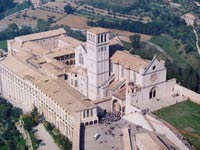 The earliest traces of human presence in Assisi assiduously date back to the Neolithic. Numerous archaeological finds indicate that Assisi draws its origins from a small village inhabited by the Umbrian already in the 9th century BC. The archaeological finds show that the Umbers had deep relationships (especially commercial) with the Etruscan neighbors, located on the western shore of the Tiber, from which however differed by language and culture.
The earliest traces of human presence in Assisi assiduously date back to the Neolithic. Numerous archaeological finds indicate that Assisi draws its origins from a small village inhabited by the Umbrian already in the 9th century BC. The archaeological finds show that the Umbers had deep relationships (especially commercial) with the Etruscan neighbors, located on the western shore of the Tiber, from which however differed by language and culture.
It is famous for being the city in which Saint Francis, patron of Italy, and Saint Chiara born, lived and died.
The city stretches on the slopes of Mount Subasio above the plain, where the Topino and the Chiascio run.
Assisi has a roman origin, but the present aspect was determined by medieval development. The oldest nucleus of the town is protected by a defensive apparatus, consisting of eight fortified access doors and a long walled wall, still in excellent conservation status, which is dominated by two castles: the Rocca Maggiore, rebuilt by Cardinal Albornotz in 1367 and the Rocca Minore. In the Piazza del Comune di Assisi, located on the ancient area of the forum, we find the Palazzo dei Priori of 1337, the 13th century Palazzo del Capitano del Popolo and the temple of Minerva, built during the Augustan era with pronaos, columns and capitals of Corinth, still intact. Nearby there are the places connected to the life of St. Francis, such as the Hermit of the Carceri, immersed in a thick oak forest and holm on the slopes of Subasio and the Convent of San Damiano, built around the oratory in which, according to tradition, the Crucified has spoken to the Saint. Finally, in the plain, the imposing basilica of Santa Maria degli Angeli was built on the project of Alessi between 1569 and 1679 to protect the Chapels of Porziuncola, the poor meeting of the first Franciscan friars.
Today Assisi is recognized as the world capital of peace, a true point of reference for pilgrims and religious around the world, who play a crucial role when it comes to peace, human rights, respect for nature, and integration among peoples of all over the world.
 To visit in Assisi
To visit in Assisi
- Basilica of San Francesco
- Basilica of Santa Chiara
- Rocca Maggiore
- Piazza del Comune and Torre del Popolo
- Eremo delle carceri in Monte Subasio
- Temple of Minerva
- Foro Romano Museum
- Biblioteca Comunale Palace
- Municipal picture gallery
- Monte Frumentario
- San Damiano Churc
- Santa Maria degli Angeli whit the Porziuncola
- Church of San Benedetto and San Matteo
- Church of S. Chiara
- Cathedral of S. Francesco
SPOLETO:
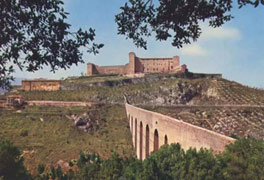 Spoleto boasts Umbrian origins. In the IV century. BC, the city passed under the influence of Rome, which founded the Colony Spoletium in 241 BC; thanks to the Roman contribution during the Punic wars, Annibale was defeated in the Battle of Trasimeno in 217 BC. The city still has an ancient - medieval appearance, due to the time when it was a flourishing Longobard Duchy and later an important center of the papal state. The oldest monuments of Spoleto are: the Druso arch of 23 AC. (at the Romanesque Church of Sant'Ansano), the Roman Theater, whose construction dates back to the early years of the Empire, the early Christian Basilica of the Fourth Century of St. Salvatore, the Roman Bridge, also called Sanguinario with three arcades in Travertine blocks and the amphitheatre of II century AC. St. Peter's Church is of great interest for the extraordinary bas-reliefs that adorn the 13th-century façade. From the space in front of San Pietro there is a wide view that embraces all Spoleto to the mighty Ponte delle Torri, 80 meters high and 230 m long, which connects the Rocca, made from 1352, project of Matteo Gattaponi, on the slopes of the mountain overlooking the town. The complex of the Duomo is unforgettable, erected in the 12th century and characterised by the richness of interior furnishings and by the mosaics of its façade, and the Romanesque Church of Sant'Eufemia.
Spoleto boasts Umbrian origins. In the IV century. BC, the city passed under the influence of Rome, which founded the Colony Spoletium in 241 BC; thanks to the Roman contribution during the Punic wars, Annibale was defeated in the Battle of Trasimeno in 217 BC. The city still has an ancient - medieval appearance, due to the time when it was a flourishing Longobard Duchy and later an important center of the papal state. The oldest monuments of Spoleto are: the Druso arch of 23 AC. (at the Romanesque Church of Sant'Ansano), the Roman Theater, whose construction dates back to the early years of the Empire, the early Christian Basilica of the Fourth Century of St. Salvatore, the Roman Bridge, also called Sanguinario with three arcades in Travertine blocks and the amphitheatre of II century AC. St. Peter's Church is of great interest for the extraordinary bas-reliefs that adorn the 13th-century façade. From the space in front of San Pietro there is a wide view that embraces all Spoleto to the mighty Ponte delle Torri, 80 meters high and 230 m long, which connects the Rocca, made from 1352, project of Matteo Gattaponi, on the slopes of the mountain overlooking the town. The complex of the Duomo is unforgettable, erected in the 12th century and characterised by the richness of interior furnishings and by the mosaics of its façade, and the Romanesque Church of Sant'Eufemia.
Among the most important events organized in the city, the Festival dei Due Mondi undoubtedly deserves a special mention.
 To visit in Spoleto
To visit in Spoleto
- Rocca Albornoziana
- Duomo (1067 AC)
- Church of San Salvatore (IV century)
- Church of Sant'Eufemia (XII century)
- Arco di Druso and Ponte delle Torri
- Roman house of Vespaia Polla
- Church of Sant'Ansano (early middle Ages)
- Sant'Agata Monaster
- Palazzo Spada
- Palazzo Racani Arroni
- Palazzo Comunale (1200)
- Teatro Nuovo (1800)
- Torre dell'Olio (XIII century)
PERUGIA:
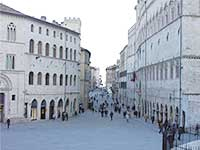 Perugia has Umbrian origins, but between VI and V sec. BC, Etruscans promoted its development. The city is located in the center of the region, with the 5 historical districts enclosed by the Etruscan walls: huge bastions formed of boulders, square, erected 22 centuries ago and still visible for long stretches; in the Etruscan Perugia, there were 7 doors, including a particularly imposing Porta Pulchra or Augusto.
Perugia has Umbrian origins, but between VI and V sec. BC, Etruscans promoted its development. The city is located in the center of the region, with the 5 historical districts enclosed by the Etruscan walls: huge bastions formed of boulders, square, erected 22 centuries ago and still visible for long stretches; in the Etruscan Perugia, there were 7 doors, including a particularly imposing Porta Pulchra or Augusto.
Entering from Porta San Pietro, rebuilt outside by Agostino di Duccio in 1475, you will find the Basilica of San Domenico; in the cloisters and in the convent the important National Archaeological Museum of Umbria was ordained. There is Piazza del Sopramuro, where the fifteenth-century palace of the Old University and the Palace of the Captain of the People are aligned. Finally, there is one of the most important squares of Italy: Piazza Grande in Perugia (Piazza IV Novembre), a superb monumental complex that includes Palazzo dei Priori, Cathedral and the Fountain of the '200 in the center.
The climbs and stairs are usually steep, both those dating back to the most remote ages and those drawn in recent times.
Among the most important events organized in the city, there are Umbria Jazz music festival and the culinary event of Eurochocolate.
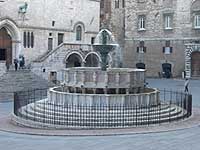 To visit in Perugia
To visit in Perugia
- Gothic Cathedral (1490)
- Arco Etrusco
- Fontana Maggiore
- Rocca Paolina and Palazzo dei Priori
- National Gallery of Umbria
- National Archeoligic museum
- Pietro Vannucci's academy
- San Domenico's Church
- Pozzo Etrusco
- Università Vecchia Palace
- Sant'Ercolano's Church
- Temple of San Michele Arcangelo
- Basilica of San Pietro
- Corso Vannucci
- Fontana Maggiore
GUBBIO:
 City State and religious symbol of great importance; this is confirmed by the remains of the walls of a prehistoric village located near of the city. Further confirmation comes from the "7 Eugubine Tables", a precious linguistic document in Etruscan and Latin characters preserved in the Museum of Gubbio, the Roman Theater and the Basilica of St. Ubaldo, patron of the city. Gubbio hosts architectural masterpieces that symbolize and recall the power of this medieval city-state.
City State and religious symbol of great importance; this is confirmed by the remains of the walls of a prehistoric village located near of the city. Further confirmation comes from the "7 Eugubine Tables", a precious linguistic document in Etruscan and Latin characters preserved in the Museum of Gubbio, the Roman Theater and the Basilica of St. Ubaldo, patron of the city. Gubbio hosts architectural masterpieces that symbolize and recall the power of this medieval city-state.
To remember: the Beni palaces, the Bargello with the famous fountain, the Captain of the People; of pure Renaissance lines, there is Ducal Palace by Francesco Giorgio Martini, that recalls and documented the significant period lived under the rule of the Montefeltro lordship, whose duchy, the city was an integral part.
Of great interest there are: the Cathedral (XIIth century), Santa Maria Nuova, where Madonna del Belvedere is painted by Ottaviano Nelli in 1413, Church and Convent of Sant'Agostino (13th century) with interior frescoes, Church of San Francesco (XIII century), San Giovanni (XII century), characterized by the Romanesque façade and bell tower, San Pietro expanded in 1505 and San Domenico, expanded in the 14th century.
One of the most important events organized in the city is the Corsa dei Ceri and the historical re-enactment of Palio della Balestra.
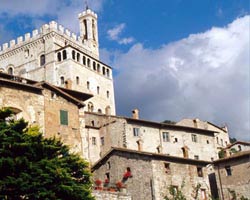 To visit in Gubbio
To visit in Gubbio
- Duomo (XIII century)
- Church of San Francesco
- Church of San Domenico
- Mausoleo
- Churches of Santa Maria Nuova and San Pietro and San Giovanni
- Sant'Ubaldo House
- Loggia of Tiratori
- Palazzo Pretorio
- Palazzo dei Consoli
- Roman rest
ORVIETO:
 Etruscans founded Orvieto and its name derives from “rbe Vetus (Old Town). Following numerous discoveries, it is assumed that the ancient Etruscan city had played a very important role in the past. In the 3rd century BC, Rome annexed Orvieto and it remained under its dominion until the decline of the Roman Empire of the West. It became free Common and during the fights between Guelphs and Ghibellines, it was a fiery opponent of Barbarossa, remaining faithful to the Pope. With the consideration of the Pontifical State, Orvieto could prosper throughout the middle Ages, reaching the peak of development in the 13th century, with the constitution of the General Council of the 400 and the election of the Captain of the People.
Etruscans founded Orvieto and its name derives from “rbe Vetus (Old Town). Following numerous discoveries, it is assumed that the ancient Etruscan city had played a very important role in the past. In the 3rd century BC, Rome annexed Orvieto and it remained under its dominion until the decline of the Roman Empire of the West. It became free Common and during the fights between Guelphs and Ghibellines, it was a fiery opponent of Barbarossa, remaining faithful to the Pope. With the consideration of the Pontifical State, Orvieto could prosper throughout the middle Ages, reaching the peak of development in the 13th century, with the constitution of the General Council of the 400 and the election of the Captain of the People.
During this period, there was a fervent work of building palaces and sacred buildings, including the famous Duomo, dating back to 1263 and the most important architectural evidence of the city, with its beautiful Gothic façade and the richness of decorations and indoor chapels. In the ancient city, you can find the Saint Patrick's Well, built in 1527 by Antonio da Sangallo il Giovane. To remember there are Teatro Mancinelli (1866), the suggestive Underground City and the Necropolis of Tufo Crucifix, dating back to the Etruscan period.
A city of well-being and culture, a city of art, known all over the world for its monuments and its wine.
 To visit in Orvieto
To visit in Orvieto
- Duomo
- Palazzo Papale
- Pozzo di S.Patrizio
- Torre del Moro
- Palazzo Comunale
- Church of S.Andrea
- Pozzo della cava
- Temple of Belvedere
- Roman Church of S.Giovenale
- Church of S.Domenico
- Churches of S.Francesco and S.Lorenzo (XIII sec.)
NORCIA:
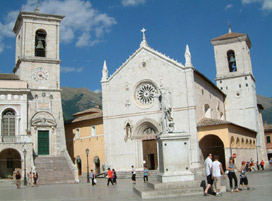 At about 600 m above sea level, the town of Norcia stands, formerly called Nursia; it has Sabine origins and is the largest city in the area. The origins of the city are remote; even in the time of the Punic wars between Roman and Phoenicians Norcia played a prominent role, as documented by Latin historians. During the Roman period, it was the center of political importance: first prefecture and then town hall. Lombards and the Goths devastated Norcia, but later it resumed and was an active medieval centre. Its historical beauties are largely damaged by the frequent earthquakes that have devastated the town over the centuries. The first documented earthquake dates back to the first half of the 1900s. Thanks to a careful restoration, today the city shows its original structure, with its beautiful medieval and noble architecture. As Cascia, the city gave birth to a very great religious character, Saint Benedict, the first monk of Christianity and founder of the Benedictine Order, who lived on horseback 500, between prayer and humility of work, as he synthesized in the phrase Ora et labora ("Pray and Work"). Duomo belongs to the Renaissance period, but unfortunately, of the original structure remains little and the restoration in the Baroque period has changed the architectural style. Another remarkable example of Renaissance architecture is the Castellina, which now hosts the Diocesan Civic Museum. Churches of St. Augustine and St. John, dating back to 1300, have lost the original structure due to the Baroque restorations. Church of St. Francis with the rose window opening on its façade is also a beautiful piece of story.
At about 600 m above sea level, the town of Norcia stands, formerly called Nursia; it has Sabine origins and is the largest city in the area. The origins of the city are remote; even in the time of the Punic wars between Roman and Phoenicians Norcia played a prominent role, as documented by Latin historians. During the Roman period, it was the center of political importance: first prefecture and then town hall. Lombards and the Goths devastated Norcia, but later it resumed and was an active medieval centre. Its historical beauties are largely damaged by the frequent earthquakes that have devastated the town over the centuries. The first documented earthquake dates back to the first half of the 1900s. Thanks to a careful restoration, today the city shows its original structure, with its beautiful medieval and noble architecture. As Cascia, the city gave birth to a very great religious character, Saint Benedict, the first monk of Christianity and founder of the Benedictine Order, who lived on horseback 500, between prayer and humility of work, as he synthesized in the phrase Ora et labora ("Pray and Work"). Duomo belongs to the Renaissance period, but unfortunately, of the original structure remains little and the restoration in the Baroque period has changed the architectural style. Another remarkable example of Renaissance architecture is the Castellina, which now hosts the Diocesan Civic Museum. Churches of St. Augustine and St. John, dating back to 1300, have lost the original structure due to the Baroque restorations. Church of St. Francis with the rose window opening on its façade is also a beautiful piece of story.
For lovers of trekking and countryside, Castelluccio's plans offer a truly unique spectacle. Indeed, between May and the first days of July of each year, Castelluccio's plans change face and show a triumph of colourful shades. A thousand of flowers blossom and plants explode in colours, with shades ranging from ocra yellow to red, from purple to white. You can find lentils (characteristic and cultivated in Castelluccio, of which they are one of the most typical products), genzianella, poppies, daffodils, violets, asphodels, purple Eugeniae, clover, molasses and many more.
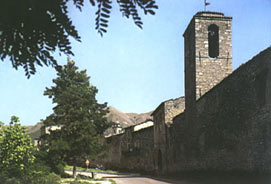 To visit in Norcia
To visit in Norcia
- Central square
- Palazzo Comunale
- Castellina
- Santa Maria Argentea Cathedral
- Tempietto (1354)
- Church of Sant'Agostino
- Church of S. Francesco (XIV sec.)
- Church of San Giovanni
- Churches of Santa Scolastica and Madonna della neve
- Basilica of San Benedetto (XIII sec.)
MONTEFALCO:
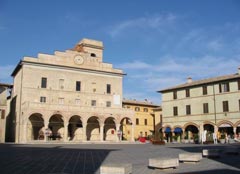 Thanks to the dominant position on the valleys of Topino and Clitunno, it offers the view of the wide panorama of the Umbrian lands. The most important buildings to visit within the ancient walls of Montefalco are: the 13th-century communal palace and the Church of Sant'Agostino, both of 1200, the Romanesque Church of San Bartolomeo with the nearby Porta di Federico II of 1244 and the Church of Santa Chiara, within which we find Umbrian paintings. The 14th-century Church of San Francesco today hosts the Picture gallery and contains very important paintings, such as a Perugino Priest and the extraordinary cycle of frescoes by Benozzo Gozzoli's Stories of St. Francis. Far away from the town center, there are the 16th century Church of Sant'Illuminata and the fifteenth century of San Fortunato, which hosts in the portal bezel and in the right alta Benozzo Gozzoli's works.
Thanks to the dominant position on the valleys of Topino and Clitunno, it offers the view of the wide panorama of the Umbrian lands. The most important buildings to visit within the ancient walls of Montefalco are: the 13th-century communal palace and the Church of Sant'Agostino, both of 1200, the Romanesque Church of San Bartolomeo with the nearby Porta di Federico II of 1244 and the Church of Santa Chiara, within which we find Umbrian paintings. The 14th-century Church of San Francesco today hosts the Picture gallery and contains very important paintings, such as a Perugino Priest and the extraordinary cycle of frescoes by Benozzo Gozzoli's Stories of St. Francis. Far away from the town center, there are the 16th century Church of Sant'Illuminata and the fifteenth century of San Fortunato, which hosts in the portal bezel and in the right alta Benozzo Gozzoli's works.
Among the most important typical products of the country, the most important is Sagrantino wine.
Each year, in August, Montefalco hosts Agosto Montefalchese, a month full of cultural, musical and artistic events in the streets and town squares. During this event, you can see the historic procession, the bender flagships and the bove's escape, which evoke the period of the highest glory of the city (1400-1500).
To visit in Montefalco
- Palazzo comunale
- Church of Sant' Agostino
- Church of Santa Chiara
- Church of San Francesco
- Pinacoteca (Picture gallery)
- Church of San Fortunato
- Church of San Bartolomeo
- Central square
SPELLO:
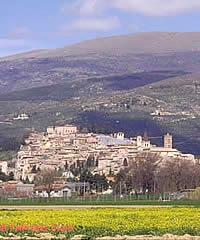 It rises between Assisi and Foligno, on a spur of Mount Subasio, above a fertile irrigated plain. Among the cities in the area, Spello is the one that has the most number of testimonies of Roman times: the walls, the remains of the theater, the amphitheater, the spas and the Consular Gate, the Urbica Gate and the Venus Gate, of the Augustan era. Climbing upwards, you reach the Church of Santa Maria Maggiore, built between the XII and the XIII century. The church shows a facade rebuilt with antique materials in 1644 and inside it has the greatest treasure: the Chapel Baglioni, on the left side of the nave, painted by Pinturicchio, with the Annunciation, Nativity, and Dispute to the Temple pictures. There are also other frescoes by the same author in the chapels of the cruise and Perugino, on the pillars of access to the presbytery. Not far away, you can visit the Church of St. Andrea, which hosts the Madonna and Santi table by Pinturicchio. Piazza della Repubblica there is the town hall, with a beautiful ogival portico and the Church of S. Lorenzo with the remains of the 12th century. The ruins of the 14th century castle, situated on top of the hill, dominate the Topino valley and the hills around it. Just outside the town, there are the Romanesque Church of S. Claudio and the Round Church, erected in the Renaissance period with a Greek cross and octagonal dome.
It rises between Assisi and Foligno, on a spur of Mount Subasio, above a fertile irrigated plain. Among the cities in the area, Spello is the one that has the most number of testimonies of Roman times: the walls, the remains of the theater, the amphitheater, the spas and the Consular Gate, the Urbica Gate and the Venus Gate, of the Augustan era. Climbing upwards, you reach the Church of Santa Maria Maggiore, built between the XII and the XIII century. The church shows a facade rebuilt with antique materials in 1644 and inside it has the greatest treasure: the Chapel Baglioni, on the left side of the nave, painted by Pinturicchio, with the Annunciation, Nativity, and Dispute to the Temple pictures. There are also other frescoes by the same author in the chapels of the cruise and Perugino, on the pillars of access to the presbytery. Not far away, you can visit the Church of St. Andrea, which hosts the Madonna and Santi table by Pinturicchio. Piazza della Repubblica there is the town hall, with a beautiful ogival portico and the Church of S. Lorenzo with the remains of the 12th century. The ruins of the 14th century castle, situated on top of the hill, dominate the Topino valley and the hills around it. Just outside the town, there are the Romanesque Church of S. Claudio and the Round Church, erected in the Renaissance period with a Greek cross and octagonal dome.
Spello hosts the event Infiorate di Spello; this is held every year during the Corpus Christi's feast (ninth Sunday after Easter). The infrared works an entire night to create carpets and floral pictures that wind through the streets of the historic centre of the quaint village to honour the passage of the Body of Christ, taken in procession by the bishop on Sunday morning. The result is a journey of about 1.5 km, characterized by the alternation of over sixty different pictures.
To visit in Spello
- Cappella Baglioni
- Church of S. Lorenzo
- Church of Santa Maria Maggiore
- Palazzo comunale
- Church of S. Claudio
- The rest of theatre
BEVAGNA:
 Bevagna, the ancient Mevania, stands at the edge of the vast Umbrian valley, at the extreme propagation of the Martani Mountains. The first historical news on Bevagna coincides with the Roman conquest of the Umbria, although there are traces of human settlements since the Iron Age and significant archaeological finds confirm the Umbrian presence in this area. Bevagna, built on the ancient Via Consolare Flaminia, was the first Umbrian city and then the Roman Mevania Town Hall, accredited to the Aemilia tribe. Mevania was centrally located in the Roman road, which, together with the flourishing commercial exchanges through its river ways, led to the flourishing until the 3rd century AD. In 774, it became part of the State of the Church. After the 1000s, it was free common held by the Consuls. Today's aspect is influenced by the medieval development; Romans had set the ancient Mevania so that the Flaminia Street was the decumano of the town, but today the urban centre of gravity is located to the south. In Piazza Silvestri, you can find the Gothic Consul Palace, the Churches of San Silvestro (1195 AD) and San Michele Arcangelo; the fountain completes the scenery of this exceptional public space and is a remake of nineteenth century. There are also the oldest testimonies of the city: the remains of a temple from the 2nd century AD, on which the medieval Church of Madonna della Neve was erected, the Roman theatre (2nd century AD) and the remarkable remains of mosaics, maybe belonging to a spa building, which represent marine animals.
Bevagna, the ancient Mevania, stands at the edge of the vast Umbrian valley, at the extreme propagation of the Martani Mountains. The first historical news on Bevagna coincides with the Roman conquest of the Umbria, although there are traces of human settlements since the Iron Age and significant archaeological finds confirm the Umbrian presence in this area. Bevagna, built on the ancient Via Consolare Flaminia, was the first Umbrian city and then the Roman Mevania Town Hall, accredited to the Aemilia tribe. Mevania was centrally located in the Roman road, which, together with the flourishing commercial exchanges through its river ways, led to the flourishing until the 3rd century AD. In 774, it became part of the State of the Church. After the 1000s, it was free common held by the Consuls. Today's aspect is influenced by the medieval development; Romans had set the ancient Mevania so that the Flaminia Street was the decumano of the town, but today the urban centre of gravity is located to the south. In Piazza Silvestri, you can find the Gothic Consul Palace, the Churches of San Silvestro (1195 AD) and San Michele Arcangelo; the fountain completes the scenery of this exceptional public space and is a remake of nineteenth century. There are also the oldest testimonies of the city: the remains of a temple from the 2nd century AD, on which the medieval Church of Madonna della Neve was erected, the Roman theatre (2nd century AD) and the remarkable remains of mosaics, maybe belonging to a spa building, which represent marine animals.
One of the most important events organized in the city is the historic re-enactment Mercato delle Gaite, held in the last decade of June. During this event, costume characters show old crafts along alleyways and characteristic environments, tasting ancient medieval flavours and presenting typical handicraft productions.
To visit in Bavagna
- Palazzo gotico dei Consoli
- Church of San Silvestro (1195 AC)
- Church of San Michele Arcangelo
- Teatro romano (II secolo AC)
- The medieval Church of Madonna della Neve
- Silvestri square
CASCIA:
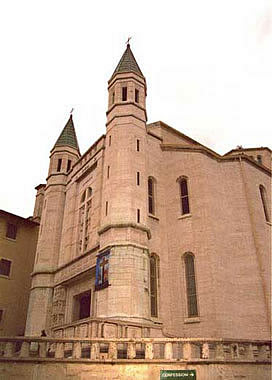 Cascia was born in Roman times, about 550 m above sea level. In origin, its name was Carsula, then changed in Cascia, during the reconstruction following a terrible earthquake that completely destroyed it. As most Umbrian cities, during the middle Ages, Cascia knew the period of maximum glory. First under the dominion of the lordship of Foligno, then under the rule of Frederick II of Swabia; then it was disputed from the nearby towns of Norcia, Leonessa and Spoleto, without success.
Cascia was born in Roman times, about 550 m above sea level. In origin, its name was Carsula, then changed in Cascia, during the reconstruction following a terrible earthquake that completely destroyed it. As most Umbrian cities, during the middle Ages, Cascia knew the period of maximum glory. First under the dominion of the lordship of Foligno, then under the rule of Frederick II of Swabia; then it was disputed from the nearby towns of Norcia, Leonessa and Spoleto, without success.
Only at the threshold of 1500, it surrendered to the Pontifical State, under whose rule it remained for about thirty years, later it always maintained its independence. Famous and Patron of Cascia is Santa Rita. She was born in 1381 in Roccaporena and she entered the Monastery of the Augustinian Sisters of Santa Maria Maddalena, following the killing of the husband by the cascians. She was blessed in 1900. Santa Rita is known as a gift dispenser all over the world and many people go on pilgrimage during the Ritiane celebrations at the Sanctuary dedicated to her, every year. The collegiate Church of Santa Maria is one of the oldest buildings in the city, dating back to the Longobard era, although it is importantly changed due to the earthquake.
To visit in Cascia
- Church of San Francesco (XIV sec.)
- Church of Sant'Agostino (1380)
- Basilica of Santa Rita
- Monastery of Santa Rita
- Roccaporena and Maltignano
- The rest of the castIe of San Giorgio
- Pieve (XV sec.)
- Eremo of Madonna della Stella
DERUTA:
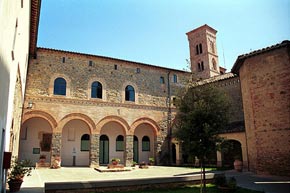 Deruta's origins remain partly obscure. Certainly, it has an ancient relation with Perugia, of which it has always been a valuable bastion to the south, towards Todi; this role is still witness to its aspect of fortified castle. In the 13th century AD, Deruta had its own statute, followed in 1465 by a new document, in vernacular, which includes the presence in the castle of a Podestà sent by Perugia and of four "boni omini", elected among the inhabitants. In the second half of 1400, the plague exterminated the inhabitants of the town, causing a reduction of the wall. In addition, during the Salt War (1540), Deruta deployed against the Pope and suffered plunder and devastation. Perugia's submission to the Church led to the town for a long period of peace, during which Deruta had the greatest development of artistic majolica work, an activity that made Deruta popular all over the world.
Deruta's origins remain partly obscure. Certainly, it has an ancient relation with Perugia, of which it has always been a valuable bastion to the south, towards Todi; this role is still witness to its aspect of fortified castle. In the 13th century AD, Deruta had its own statute, followed in 1465 by a new document, in vernacular, which includes the presence in the castle of a Podestà sent by Perugia and of four "boni omini", elected among the inhabitants. In the second half of 1400, the plague exterminated the inhabitants of the town, causing a reduction of the wall. In addition, during the Salt War (1540), Deruta deployed against the Pope and suffered plunder and devastation. Perugia's submission to the Church led to the town for a long period of peace, during which Deruta had the greatest development of artistic majolica work, an activity that made Deruta popular all over the world.
In the historic center of Deruta, due to the importance of this production, there is a specific regional museum, an extension of the one established by the native Briganti lawyer, where there is a rich display of artifacts, as well as spaces for theme exhibitions.
On November 25th, holy feast of St. Catherine of Alexandria, patron of ceramists and Saint Simplicio patron of the city, is held the ceramist party, in addition to the award ceremony in the church of the oldest ceramists in the country.
To visit in Deruta
- Church of S. Michele Arcangelo
- Picture gallery
- The ceramics museum
- Church of S. Francesco
- Church of S. Antonio
- Church of Madonna delle Piagge
AgriTrosciole
loc. Viepri di Massa Martana (PG)
p.iva 03013500545
tel. +39 328 257 4122
tel. +39 328 567 9048
e-mail: info@agritrosciole.it
Our products
- Extra Virgin Oil
- Red and white wine
- Summer truffle or Scorzone
Activities
- Horse riding
- Mountain biking excursions
- Tennis, mini football, sport fishing and flying
- Harvesting of olives and grape harvest
- Picking Truffles, Asparagus and Mushrooms
Services
- Apartments
- Swimming pool with sun beds, deckchairs and umbrellas
- Garden
- Children’s play area
- Gas oven
- LCD TV



